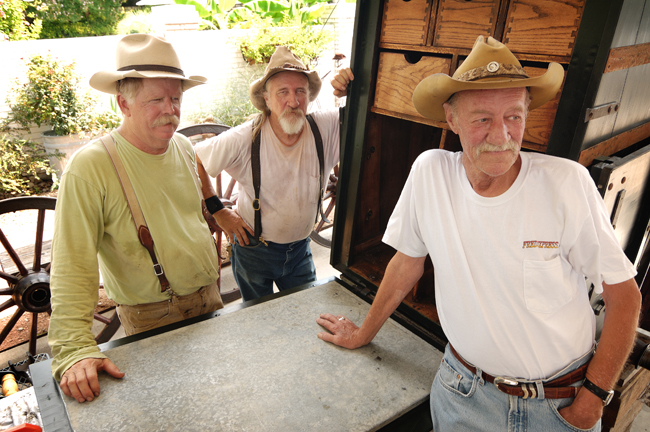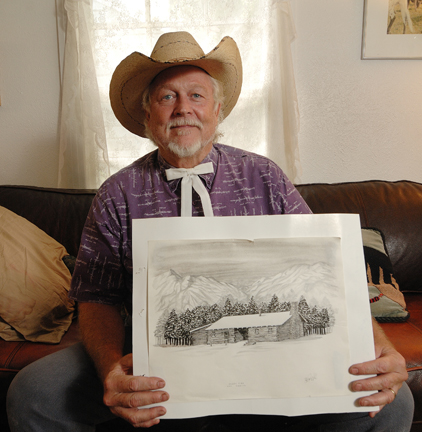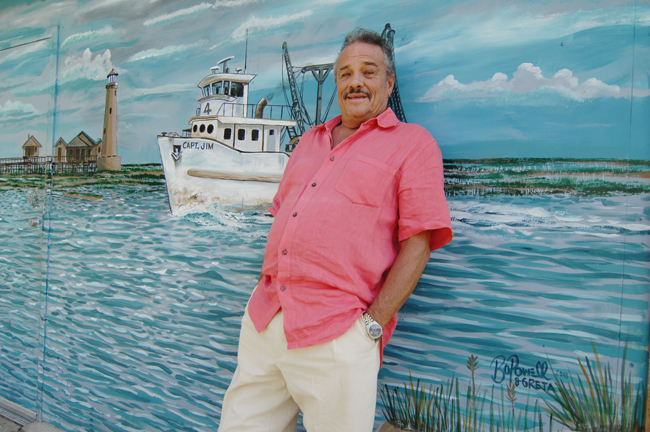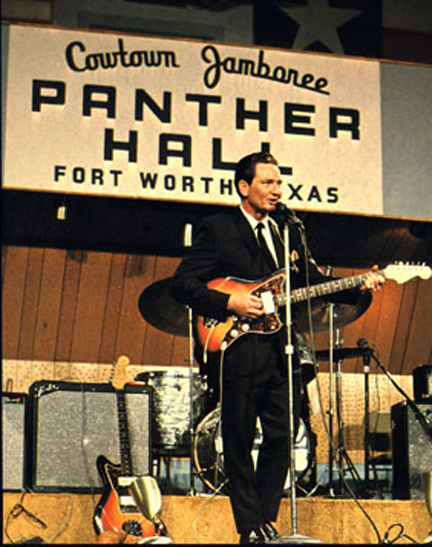Out behind Lola’s Saloon, Bo Powell is staring at the mural he finished recently for the bar’s new outdoor stage — there’s the Trinity River green space, a Fort Worth skyline, and F-16 fighter jets shooting past.
Powell, who just turned 70, doesn’t much enjoy discussing his paintings, but he does offer one fact: He finished the 20’ x 15’ work in less than two weeks.
 “When people want to hire me to do these kinds of murals, I say they can have quality, speed, or price, but they can only pick two,” he says with a laugh.
“When people want to hire me to do these kinds of murals, I say they can have quality, speed, or price, but they can only pick two,” he says with a laugh.
Well, maybe he’ll point out just one detail that most viewers might miss: A close inspection shows one of the fighter pilots is shooting the finger.
“I like to have a little fun,” he says.
Powell has been painting — on canvases and walls, indoors and out — for almost 60 years now, and his paintings and folk-art murals have a certain following. Still, his name is mostly unknown in art circles, even in his hometown of Fort Worth.
You’ve probably seen his work though — say, at the Paris Coffee Shop, where his mural shows cowboys, cattle, freight trains, oil wells, fighter jets, and, yes, a dog pissing on a sign that points to Dallas. Or in another mural on an electrical supply company building a few blocks away, painted about six decades ago. Or at Sardines Restaurant ( a Tuscan-themed mural) or at any of a number of bars and restaurants around town. Maybe you saw some of his paintings at the Morton House Gallery that displayed his work for years, until West 7th Street redevelopment brought about its closure.
His murals are mostly unsophisticated in technique and subject. His paintings and pen-and-ink works, however, show a sure hand and an eye for detail.
“He’s wonderfully diverse,” said Trudy Bryant, owner of the Morton House Gallery. “His work sold pretty well, but he often got less money because he was a little too generous when people wanted to pay less.”
Mary Rose, executive director of the Art Center for the Islands in Port Aransas, has been showing Powell’s work for years, primarily his paintings and pen-and-ink drawings. She defines his style as more representational than folk art. “His paintings and pen-and-ink drawings are done with great detail,” she said.
 Powell’s not too worried about it all. He’s not much on promoting his work or his rep as an artist. “If they like my art and want to buy some or have me do some work for them, fine,” he said. “But I don’t like to meet people and push a business card at them.”
Powell’s not too worried about it all. He’s not much on promoting his work or his rep as an artist. “If they like my art and want to buy some or have me do some work for them, fine,” he said. “But I don’t like to meet people and push a business card at them.”
His paintings are “stuff I’ve already done,” he said. “I’d rather talk to people and hear about them.”
That stuff he’s already done, however, includes far more than painting. He’s worked on freight and passenger trains and offshore oil rigs, been a long-haul trucker, a race car driver, and a chuck-wagon cook. He was an expert trick water skier, and in his time as a local radio DJ may have helped spark the career of a major music legend.
“He’s dabbled in everything and experienced it all,” Bryant said. “He’s the Fort Worth renaissance man. Or maybe we should call him the ‘Renaissance cowboy.’ That sounds better.”
Anyone who has talked to Powell for more than 15 minutes knows at least one thing about him: that there’s more to learn. People use the word “amazing” a lot when they talk about him.
Lionel Bevan, a former rodeo competitor, fashion model, ranch hand, and actor (he appeared in Tender Mercies, Born on the Fourth of July, and 10 episodes of Dallas) met Powell about 25 years ago and continues to sell some of his art through his Everlasting Productions company.
“I was doing some of my own painting back then, and a whole lot of artist types were hanging out at a studio on the North Side,” said Bevan, who now lives in Dallas. “Everyone was telling me, ‘You got to meet this guy Bo Powell.’ I kept asking them why. ‘His art is great, he’s an interesting guy,’ they said, ‘but most importantly, he has done just about everything there is to do.’
“All of that was true,” Bevan said. “I learned he was a gifted writer. I heard about all those train stories. … I’m still learning more about him.”
He recalled a time, decades ago, when Powell proved to be a pretty entertaining companion on a road trip. Powell played a tape of train whistles, Bevan said, and could “tell you what kind of train it was, the exact location when recorded, and the number on the side of the train.” The next tape was Powell’s own poetry.
Terry Chandler, owner and chef at Fred’s Texas Café, employs Powell as a member of his chuck-wagon catering team. Powell helped paint and restore the wagon, dubbed Ought-Zero, and the crew sometimes does demonstrations at area schools. “After we’re done cooking them beans and biscuits, Bo will sit down and tell them stories about the Old West,” Chandler said. “He just loves telling stories to kids.”
Kids aren’t his only willing audience. “He also tells fun stories to the rest of us while we’re cooking — about his radio days, about the freight trains,” Chandler said. “But we usually have to pull it out of him.
“I’d say that if I had to give him a title, it would be the poet laureate of the chuck wagon,” he added, laughing.
Powell grew up on Fort Worth’s East Side and began painting at about age 10 at his father’s business. The company — Bob Powell Display Art — produced outdoor signage and trade show booths.
One of the first outdoor wall signs Powell worked on was for the Nathan Frankel Electric Supply company on the south side of downtown. The signage he worked on during the 1950s can still be seen today.
He graduated from Polytechnic High School in 1957 and enrolled at Texas A&M University, where a pre-law major eventually turned into a degree in business administration with a minor in commercial art. During the summers, he worked on West Texas oil rigs. After graduation he put that business degree to work on an offshore rig in the Gulf of Mexico.
“It was 10 days on the rig and then 10 days off,” Powell said. “But while all the other roughnecks were going into New Orleans to drink for their 10 days off, I was driving back to Fort Worth. I had just gotten married with a baby on the way, so I had to be home.”
Eventually he made his way back to Fort Worth permanently, working for his father’s company and as a brakeman for the Rock Island Railroad. He would work for the railroads off and on for more than 40 years. But it was his interest in another mode of transportation — faster, flashier, and off the rails — that would lead to another career and to a mark on history that may last as long as any mural Powell has painted.
 In the 1950s and ’60s, Green Valley Raceway was a drag strip in what is now North Richland Hills. Outside the drag strip was a road course where the Sports Car Club of America held amateur races on weekends. And every chance he got, Powell was behind the wheel for those amateur races, driving for a mechanic friend of his.
In the 1950s and ’60s, Green Valley Raceway was a drag strip in what is now North Richland Hills. Outside the drag strip was a road course where the Sports Car Club of America held amateur races on weekends. And every chance he got, Powell was behind the wheel for those amateur races, driving for a mechanic friend of his.
Powell had convinced his friend to let him race a high-powered Triumph. “We put in a roll bar, jacked up the engine, and fixed the brakes,” Powell said. But his career in the Triumph didn’t last long. “The brakes didn’t work very well. In my third race, I hit the brakes going into a turn, and they didn’t work. Rolled that Triumph.”
Radio personalities from KCUL-AM would call the races over the speaker system at the track. One day in 1963, the usual color commentator didn’t show, and the DJ asked Powell to sit in for him. The DJ liked Powell’s performance well enough to offer him a job at the station.
He started out on Sundays, mostly playing gospel music tapes, not saying much on air. “But I learned how to work the board,” he said. “It was different and fun.”
It was a good thing he learned fast. About a month after his first day at the station, President John F. Kennedy was assassinated in Dallas. “The radio station called in every employee, and I spent the next 48 hours at the station,” Powell recalled. KCUL concentrated on music, not news, but no media outlet could ignore that story.
“I spent the next week or so taking the [Associated Press] wire reports and ripping and reading,” Powell said. “The management thought my voice was very good, and they offered me a job doing afternoon drive.”
 Powell had gotten into radio during a time of change. KCUL had a 50,000-watt signal and could be heard across half the nation. Like many stations, KCUL played “hillbilly” music only once in a while. But Nashville was starting to crank out the hits. The genre was becoming more mainstream, and just before Powell took the drive-time slot, the station switched to country music. One of the young talents in that genre was a local guy named Willie Nelson.
Powell had gotten into radio during a time of change. KCUL had a 50,000-watt signal and could be heard across half the nation. Like many stations, KCUL played “hillbilly” music only once in a while. But Nashville was starting to crank out the hits. The genre was becoming more mainstream, and just before Powell took the drive-time slot, the station switched to country music. One of the young talents in that genre was a local guy named Willie Nelson.
This was also a time when DJs could play whatever they wanted, without following some corporately chosen play list. Powell knew Nelson and quickly realized that he had written some of the most popular songs on the air. “Patsy Cline’s ‘Crazy,’ Faron Young’s ‘Hello Walls,’ and Ray Price’s ‘Night Life’ were all big hits, and I kept seeing Willie’s name on the singles,” Powell said. “Willie had also put out some of his own albums, and they were good, but they got no traction.”
Powell helped change that.
Panther Hall on East Lancaster Avenue started out as a huge bowling alley in 1961, but the owners soon turned it into a rock ’n’ roll concert venue. Elvis Presley played there early on, but rock ’n’ roll wasn’t drawing big enough crowds. So the owners’ next idea was to convert the place to country music.
Some of the biggest names of the era played Panther Hall — Jerry Lee Lewis, Charley Pride, Loretta Lynn, Porter Wagoner, Dolly Parton, Johnny Cash. A 14-year-old named Tanya Tucker made her first appearance there.
Radio DJs emceed the shows, and Powell landed a place on that rotating list, among names like that of legendary Bill Mack. The popularity of country music at Panther Hall eventually spawned a local Saturday night TV show called Cowtown Jamboree on KTVT/Channel 11, and Powell hosted many of those shows as well.
Panther Hall booked Nelson’s band several times in 1964, but the crowds stayed away. The owners turned Powell down when he suggested another gig for Nelson.
“I told them to give me about six weeks,” he said. “What I wanted to do was to play Willie as much as possible … and see if we could get a good crowd in for his show. The [Panther Hall] owners said they would buy me a pair of expensive cowboy boots if that happened. I eventually got my boots.”
Since Nelson’s first two albums hadn’t done well, Powell thought the singer might do better with the songs he’d written for more famous musicians.
“I knew Willie had lived in Fort Worth, and many of the popular hits were written by him, so we had a good local angle,” Powell said. “So I just played everything Willie wrote, either sung by him or others. And when I played those songs sung by Ray Price or Faron Young, I made sure I mentioned they were written by Fort Worth’s Willie Nelson and that he would be playing next month at Panther Hall.”
Nelson drew about 2,000 people for that show, and his career took off. In his autobiography, he would later thank Powell for his role in helping him break out of the Nashville scene.
Texas author Joe Nick Patoski wrote a biography of Nelson (Willie Nelson: An Epic Life) and highlighted the role Powell had in jump-starting his career.
“KCUL was the only country-Western-formatted station in such an important market, and getting played on that station was huge,” Patoski said recently. “What Bo Powell did for Willie Nelson’s career is pretty significant. The moment Bo hyped Willie there was a line outside the door, and it’s been like that ever since.”
By 1965, Nelson’s His Own Songs, charted at number 14. A live album recorded at Panther Hall was released in 1966, with an introduction by Powell. It eventually went gold.
Within a few more years, Powell found that he was tired of the radio business. The pay wasn’t good, and he had kept his nighttime job as a switchman at the rail yard. He and his wife had split up, and the rails were calling.
“I’d get maybe four hours of sleep a day,” he said. “So with my marriage ended, I thought it might be fun to travel around the country. So I applied for a conductor’s job, and Fort Worth & Western put me back on the train.”
 Powell had always been fascinated with trains, even hopping freight trains to Dallas as a kid. As a conductor, he frequently worked the Oklahoma-to-Houston leg of the Rock Island Rocket, a passenger train that ran from Minneapolis to Houston. But it was his conductor work on freight trains that took him around the country.
Powell had always been fascinated with trains, even hopping freight trains to Dallas as a kid. As a conductor, he frequently worked the Oklahoma-to-Houston leg of the Rock Island Rocket, a passenger train that ran from Minneapolis to Houston. But it was his conductor work on freight trains that took him around the country.
That travel had a profound influence on his art.
“You can’t draw things unless you see them with your own eyes,” Powell said. “I was able to travel through rolling landscapes, see thunderstorms forming on the horizon, get up close with the coastline. And I was able to meet so many people from all over the country and learn so much from them.
“Trains have their own personalities, based on the people working on them,” he recalled. “The black guys who worked as porters in the Pullman cars had been doing it for so many years, and they had this sense of history. There is a lot of down time when working on a train, and I loved to just sit and talk to these guys about their life experiences, good and bad.”
Much of a conductor’s time is spent in the caboose filling out paperwork. His chores finished, Powell would draw. The ink drawings he did in those hours, as the country rolled by beneath him, turned into paintings once he got home.
One such work was Texas Panhandle in 1927, which was recently put up for auction by the Heritage Auction Galleries in Dallas. The painting, a dramatic view of a thunderstorm rolling in over the plains, didn’t draw its minimum asking price of $1,200. Powell eventually pulled it from the auction when a Fort Worth attorney accepted the painting as payment for some legal work. (Powell’s paintings and pen-and-ink drawings usually sell for $150 to $1,250. He charges $2,000 to $5,000 for murals, depending on the size and complexity.)
“I guess it is one of my favorites,” he said of the Texas Panhandle painting. “I saw a lot of scenes like that storm blowing through while on the train, and they burned into my brain. And that is what I like about train travel so much. When you travel by car, you only see that highway concrete in front of you. With trains, it is just a panorama of views.”
 As part of its public art program, Fort Worth is on the muralist bandwagon these days. The program, funded through the city’s capital improvements budget, paid for the sculptures in the median of Lancaster Avenue downtown, for the four Western-themed mosaics at the new parking garage at the Will Rogers Memorial Center, and, coming later this year, a mural by local artist Manuel Pulido.
As part of its public art program, Fort Worth is on the muralist bandwagon these days. The program, funded through the city’s capital improvements budget, paid for the sculptures in the median of Lancaster Avenue downtown, for the four Western-themed mosaics at the new parking garage at the Will Rogers Memorial Center, and, coming later this year, a mural by local artist Manuel Pulido.
The $25,000 mural, the first commissioned by the public art program, will grace the Northside Community Center on NW 18th Street. Area schoolchildren will help Pulido paint it.
“We don’t have a set plan moving forward. This is just a pilot program, and we’ll see where it goes from there,” said Jenny Conn, collections manager for the Fort Worth and Tarrant County Arts Council, which manages the program. “One thing we’ve seen in other cities is that large public paintings can create public space. Vacant lots can turn into community gardens, so there is a public benefit to doing these murals.”
Powell attended a workshop put on by the city a few weeks ago to let artists know about the program and get their input. But one suggestion put him off: a peer review committee that would work with artists to ensure that the content of outdoor murals would align with the wishes of neighborhood and community groups.
“I’m glad to see the city reaching out to artists and doing more murals, but it would be a bureaucratic nightmare to have what I paint approved by the city,” he said. His work is often commercial in nature — and Powell figures that what’s in those murals is between the property owner and the artist.
When local restaurateur Jim Schuessler opened his second J&J’s Oyster Bar in Burleson a few months ago, he tapped Powell to create a mural, since the artist had done other work for him, including designing the restaurant’s logo. “I just told him I wanted something with an ocean-style element to emphasize that this is a seafood restaurant,” he said. “Then it is up to Bo. He does whatever he thinks will work.”
The mural, completed about a month ago, shows a bay scene with shrimp boats and a little harbor town — exactly what Schuessler wanted.
Brian Forella has also worked with Powell. When Forella knew his West 7th Street bar, The Wreck Room, was going to be sacrificed to new development in the area, he started thinking about what he wanted its replacement to look like. He talked to Powell about it over drinks at what would soon be another victim of redevelopment — J&J’s Hideaway bar.
“I kept telling people I wanted to do an old-style saloon, very Fort Worth-ish in style,” Forella said. “I wanted to do something that was very different from all the chains that were going to pop up in these new developments. No one knew what I was talking about. But Bo got it immediately and ran with it.”
And so, in Lola’s Saloon on West Sixth Street, there’s a mural by Powell depicting the Tarrant County Courthouse and Main Street in the early 1900s. He even wrote a biography of the fictional Lola, whom he saw as a Cajun beauty and lady of the evening. Powell designed the logo and signage throughout the bar and recently created the mural out back.
“What he is able to do is turn my ideas into Bo ideas,” Forella said. “I’m no art expert, but everything he’s done here fits into the concept of what we wanted this place to be. Bo always gets that.”
Powell’s work may be familiar to patrons and owners of local bars and other businesses, but it rings nary a bell with local museum officials or gallery owners other than Bryant.
Morris Matson, a founding member of Collectors of Fort Worth Art, a local art advocacy group, looked at Powell’s work on his web site and said he thought the artist has talent. Matson also is pleased that the city is encouraging murals.
“Some of the [muralists] have more artistic ability than others, as Powell appears to have, and they provide a great service by capturing the feel of the moment,” he said.
Powell keeps painting because he loves it. On most days he is up before dawn, listening to old C&W or Jimmy Buffett music and painting until early afternoon. After that, he usually goes out for a few drinks with friends, comes home, and turns in early.
With the Morton House Gallery closed, Powell is now looking for a new place to show his work. His paintings and drawings have been displayed for many years at art galleries in Port Aransas and Santa Fe, but he misses having a local connection. Still, he’s not worried.
“I don’t work as hard as I should in marketing and selling my art,” Powell said. “I don’t hang out with the rich people who buy art, because that’s not who I am. I just love to paint. The rest of the stuff will work itself out.”












When I was growing up in Fort Worth, my parents used to play bridge with Bo and his wife. I was only 14 or 15 at the time, but boy did I look forward to Bo coming over. He had the BEST stories. My Daddy was at Green Valley the day Bo flipped that Triumph. I never heard any of his train hopping stories but my parents did. My favorite photo of my Mother was taken by Bo in his studio. I’m so grateful I ran across this story and saw the pic of Bo. There’s another photo in this article I recognize…Lionel…
What a fun afternoon I’ve had reminiscing.